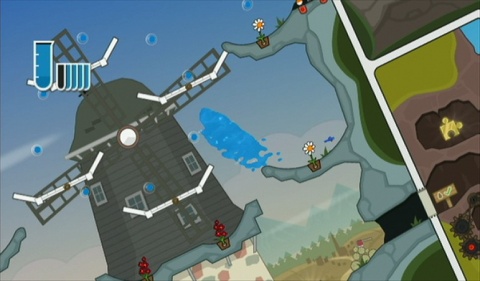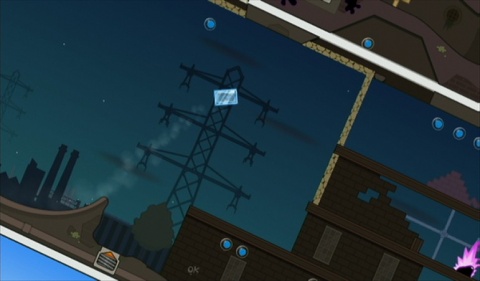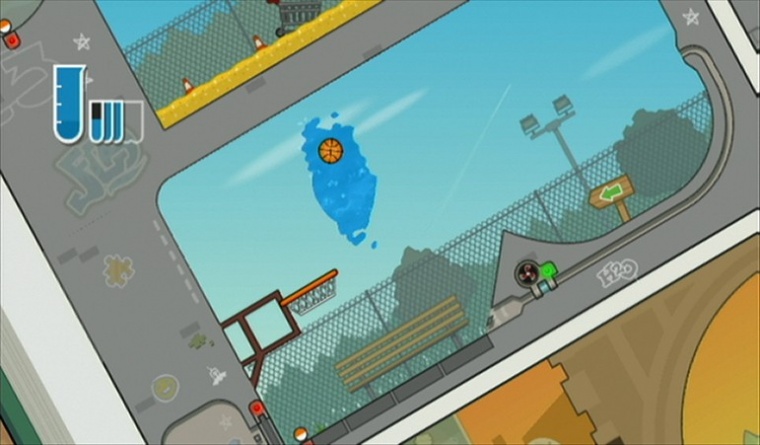Fluidity
| Fluidity | |
|---|---|
 |
|
| Platforms | WiiWare |
| Genre | Puddle puzzle platformer |
| Score | 9  |
Thanks to the indie uprising, we have a heightened visibility for games that might have gone unnoticed just five years ago. A garage developer's labor of love can now share front page headlines with the AAA behemoths of the industry. Many fine media outlets even make a special effort to cover these smaller productions. Indie games have become the punk rockers of the industry, offering a lean alternative to overproduced AAA formulas, often with rebellious verve and spunk.
But even in this new era, where the little guys yield as many pageviews as their big budget competition, an indie game needs to have some innovative hook or bombastic message in order to rise to the top. I can think of no other reason why Fluidity, a brilliant puzzle platformer with Metroidvania elements, has gone largely unnoticed. (Except that the game is marooned on Wii's invisible WiiWare digital distribution service, that is.)
It makes sense, though, doesn't it? So many indie darlings that went big had some kind of divergent angle. Limbo and Braid made their names with artsy themes and visuals that you just don't see in big money productions. The cheery brutality of Super Meat Boy, Magicka, and Castle Crashers upgraded them from mere mechanical joys to acclaimed game experiences. Fluidity, on the other hand, lifts its style and mood from airline safety manuals, of all things.
That's not to say Fluidity is ugly, as the smooth primary colors never strain your eyes. The game's music and locales are equally bland; even after I've played the game for fifteen hours, I have a hard time recalling a specific song or backdrop. There are no heroes or villains either, just some sentient mounds of matter that act as avatar and obstacle. This isn't necessarily for the worse; I actually appreciate that the game downplays context and instead leaves the experience of play mostly unadorned. I just wonder how difficult it must be to create buzz for a game with no characters or themes, an intentionally uninteresting art style, and music that can best be described as "present."
In the absence of hype, mentions of Metroidvania-style exploration are what prompted me to check out Fluidity. But truth be told, Fluidity doesn't offer the same sense of discovery and pathfinding that the labyrinthine tunnels of Super Metroid and Castlevania deliver. Each "chapter" is laid out like a comic book, with each rectangular panel presenting a scenario for one or more puzzles. You won't find any secret entrances or shortcuts between the pages, but many areas are inaccessible until you acquire a new ability from a later chapter.
Ability acquisition is the one way that the Metroidvania feel is infused into Fluidity. You begin the game as puddle of water, tilting the Wii remote to slide across the ground and shaking to make the liquid jump. The puddle learns a few tricks through the adventure, and you'll also gain the option to freeze into a block of ice or boil into a cloud of vapor, each of which has its own tiny upgrade path as well. By the game's halfway point, you'll have access to all three states of matter and their extra frills, using each to make your way through the puzzle-filled environs. The goings can be a bit tedious when you need to switch between water and ice and vapor at designated temperature stations in order to make your way to the next unsolved puzzle, but the connectivity between each puzzle panel does contribute to a sense of travel that I prefer to the linear, stage-by-stage route that the designers could have taken.
Those puzzles, though, are the game's high point and some top notch 2D puzzle platforming. Fluidity's scenarios should be somewhat familiar to those experience with puzzle games: carrying a key to its lock, rotating gears to power machinery, and managing gates are all well trod. But the use of light fluid dynamics provides a fresh take on the processes, even as the player's inherent understanding of water makes the game mechanics easy to grasp.
You probably don't think water and ice cubes and steam clouds as versatile playable "characters," but each of the three states of matter has its own distinct charm in vein with the classic action group formula. Water is the Brains, effective all-around but most often tasked with carrying tools, powering machinery, and other cranial duties. Ice is the Muscle, using old-school speed and power to jump gaps, climb walls, and smash barriers. Vapor is the Wild Card, unleashing a surprise lightning bolt to spark machinery and operating at heights where the grounded Brains and Muscle have no use. The early goings drastically raised my hopes for puzzle variety and quality; thanks to this group dynamic and the diversity of puzzle layouts, I was not disappointed in either aspect. Even as my tally of collectables jumped past the three digit mark, I was consistently delighted by some new situation that looked familiar but ended up different somehow.
The novelties do eventually run out, and unfortunately Fluidity doesn't quite know where to stop. The 89 Rainbow Drops, your reward for solving puzzles and the primary goal of the game, are supplemented by 60 optional Puzzle Pieces that unlock a handful of high score mini-challenges. Unfortunately, dozens of the Puzzle Pieces are hidden behind facades of the game world that look like solid wall but reveal the hidden path within only when you make contact with them. There is no in-game tally or mapping system that helps you narrow down their possible hideouts, either. To find every Puzzle Pieces, you'll need to hug every wall in all four chapters, an inexcusable chore in a game where every movement is so deliberate. I had every intention of finding every Puzzle Piece in the game until I spent an hour searching out these mirage routes. I decided to shelve the game for good when nothing came of my efforts.
As far as I'm concerned, those diabolically hidden Puzzle Pieces are Fluidity's one major failing, and their annoyance only applies to completionists like me. It's possible that some characteristics of the game won't gel with most players, however. The motion controls might be a concern, as they make some of the more sensitive platforming segments tougher than they might have been with buttons. I had some occasional frustration with jumps that would have been routine in another game, but I found the added complexity of control fit the game's brainy mood. The aforementioned bland style would understandably turn off anyone looking for something "more" than puzzles. Tragically, I think the game's lack of exposure could be attributed to that.
But that's just the way popularity works. Shock value and fanboy fodder are a surer path to the front page than mere excellence. I can't help but think that Fluidity might have been another indie smash hit if only some scandal or courtroom complication had mired its development. As it happens, though, it's just an excellent game that somehow slipped by the spotlight.




